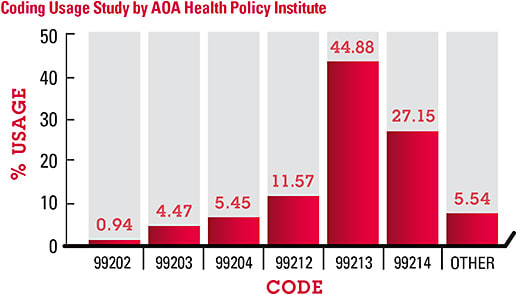A long-time colleague who directs a chart review and claims service told me that before accepting any new client, she first conducts a review of the practice’s patient charts. Her reason for this prerequisite? The firm has no interest in working with practices unless they are committed to excellent patient records and compliance with national standards for recordkeeping and claims submission.
Doctors of optometry are expertly trained in the diagnosis and management of conditions of the human eye, adnexa and related structures and have made investments in staff selection and training, their practice setting, and the instrumentation necessary to skillfully and practically care for their patients. That said, clinical acumen has not prepared optometrists for the business side of providing care, especially the vagaries of choosing codes to represent services, understanding contractual requirements of insurance companies and training staff to submit insurance claims, process payments and rejections, resubmissions, etc.
As a result, optometrists have several courses of action as they make their commitment to excellent patient records and compliance:
- Use internal staff to process claims, doing everything possible to ensure staff can access additional information, resources and training to enable them to stay current and effective, or;
- Conduct a search to find and hire additional staff who have the training, skills and experience necessary for claims submission and processing, or;
- Consider contracting with an outside service experienced in, skilled at and eager to create and submit claims and handle payments for eye care practices.
For doctors who have been successful in finding the right staff member(s), providing the training and enjoying an efficient claim submission and collection process, no options are needed. But, for doctors who have not been that fortunate, outside billing services may be helpful.
Here are some steps to determine whether outsourcing may be right for your practice.
1 ASSESS NEEDS
Meet with your fellow doctors, office manager and key staff to assess the following areas:
- Are doctors and assigned staff capable and comfortable with their responsibilities related to completing and reviewing patient charts, identifying shortcomings in record keeping, matching procedure codes and diagnosis codes to the details of each patient visit and completing and submitting claims to medical insurers and vision plans?
- Are bills and claims sent to the patient and/or the patient’s insurer expeditiously; how quickly are payments received, and how quickly are delayed and/or rejected claims resolved?
The answers to these questions, such as “no” for the first one, or a length of time that is burdensome to your practice’s financial health, for the second, may indicate a need to investigate outsourcing.
2 IDENTIFY A BUDGET
Have your accountant assist in determining the actual cost of creating, submitting and processing payments, including the expenses related to the salaries of key staff, the true dollar cost of delays in timely submission, refiling, collection of claims and other related expenses (ongoing staff training, allocation of office space, additional workstations, enhanced internet capacity, etc.). This number will provide you with a budget that you’ll want to be respectful of should you identify a partner.

3 ASK COLLEAGUES
Consult with colleagues who are utilizing a claims submission service to learn whether they have seen improvements in medical record keeping (such as enhanced thoroughness/accuracy of patient records), increased accuracy in choosing diagnosis and procedure codes and improved third party relations, such as timely submission, faster reimbursements, fewer rejections, etc. Other key factors to consider: enhanced doctor and staff confidence and satisfaction, patient satisfaction with billing and payments and key staff persons’ ease of working with and overall satisfaction with the claims processing service.
4 IF YOU DECIDE TO USE A SERVICE, SEE WHICH ONE IS THE RIGHT FIT
- Do a search, and create a list of claims-processing services available in your area.
- Determine which of the services have worked with eye care practices.
- Invite representatives of one or two services that seem to fit your needs to present their program to doctors and key staff.
- Ask each service’s representatives whether they are currently working with your type of records (paper or electronic) and the extent to which they’ve worked with your specific brand of EHR.
- Ask each representative for assurances regarding any errors they may make in submitting or processing a claim and the company’s liability if and when the errors are theirs.
- Consider the pros and cons of each billing service, and then make the final decision by extending an offer to hire an outside firm.
DELEGATE
As eye care practices have become more complex, so have the rules and requirements of submitting claims for those services. Creating and processing claims for Medicare, other major medical insurers and vision plans is not a job for amateurs or the faint at heart.
Few doctors are prepared for or have any interest in the vagaries of creating and submitting claims to insurers for payment, yet that is today’s environment. Happiness comes when doctors can delegate these tasks to knowledgeable folks inside or outside their practice. OM
Find more information about Coding Strategy in the column by Dr. April Jasper.
Keys to an Internal Chart Audit
HERE ARE THE KEY ITEMS to look out for when performing an internal chart audit:
- That the claim is supported by the doctor’s record and patient’s need.- That the patient record includes tests that were done, diagnoses and recommendations to the patient.
- That the codes are reflective of “Current Procedural Terminology and International Classification of Diseases-10th Revision” and rules and requirements of the insurers with which the practice is contracted.




